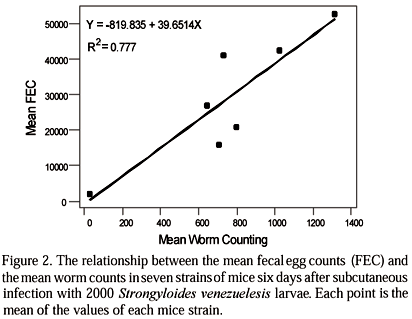A trial was carried out to investigate the susceptibility of seven strains of mice to Strongyloides venezuelensis primary and secondary experimental infections, in order to provide the basis for genetic studies about resistance. Twelve six-week-old male inbred mice of the A/J, BALB/c, CBA/J, C3H/Hepos, C57BL/6, DBA/2 and NIH strains were infected s.c. with 2000 infective larvae. The mean worm counts (± SD) in the small intestine six days after infection were, in increasing order: 28 (± 19) in NIH; 647 (± 228) in BALB/c; 709 (± 425) in DBA/2; 731 (± 151) in C3H/Hepos, 801 (± 174) in CBA/J; 1024 (± 267) in C57BL/6 and 1313 (± 483) in A/J. C57BL/6 mice showed the highest fecal egg counts and NIH, the lowest. No eggs in fecal exams or nematodes in small intestines were recovered from animals reinfected 14 days after primary infection. NIH strain was highly resistant to primary infection by S. venezuelensis. The most susceptible of the other six strains appeared to be the C57BL/6 strain which presented a high nematode counting in intestine and the highest egg output.
Strongyloides venezuelensis; mice; inbred; resistance



